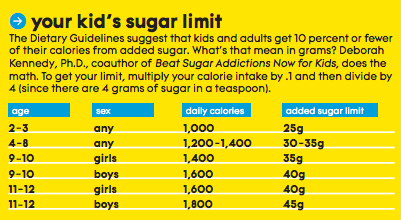
Nutrition Facts labels include the amount of sugar, but it's a combo of the naturally occurring and added kinds. The FDA may eventually require a separate notation for added sugar, but in the meantime take these steps:
1. Look at labels. If any grams of sugar are noted in the Nutrition Facts, check for fruit (but not juice), milk, or yogurt in the ingredients list. If there's none, then the sugar is added. See something? Then…
2. Find a nonsweetened cousin. Note the number of sugar grams in plain yogurt, milk, or even unsweetened tomato sauce and subtract it from the amount on a similar sugary version. Make sure you're comparing the same sizes. Can't find anything related, then…
3. Pull out your phone. Download the Fooducate app (free for Apple and Android devices), where you can find the amount of added sugar in foods (including brands), and tally your daily intake.
Aren\’t all sugars the same?
The naturally occurring sugars in dairy products and whole fruit don't count toward your child's added-sugar limit. They get a pass because the body doesn't process them in the same way as sugar that has been added to food, says Parents advisor David Ludwig, M.D., director of the obesity-prevention center at Boston Children's Hospital and author of Always Hungry? "Their cellular scaffolding, which is made of fiber and other nutrients, takes more time to break down in the digestive tract, so they don't cause large spikes in your blood sugar," he explains.

Parents Magazine
